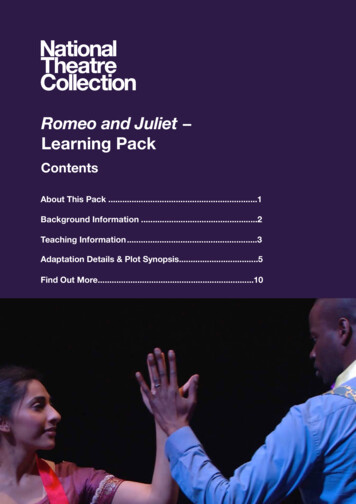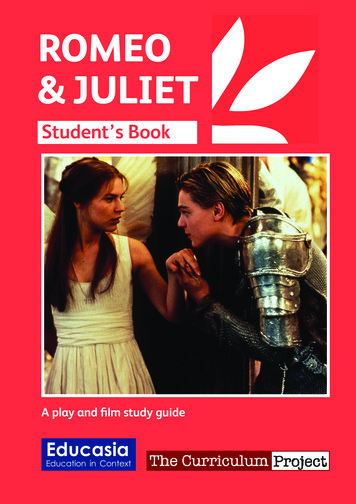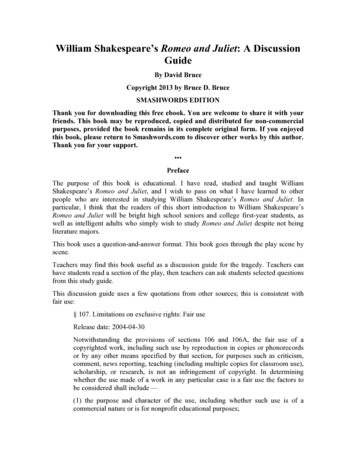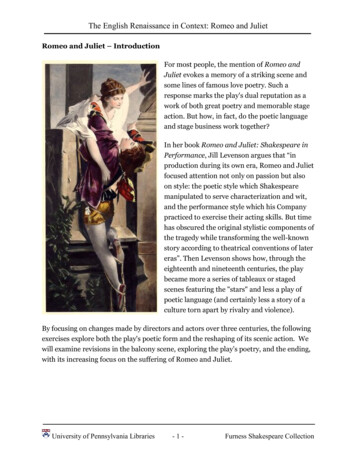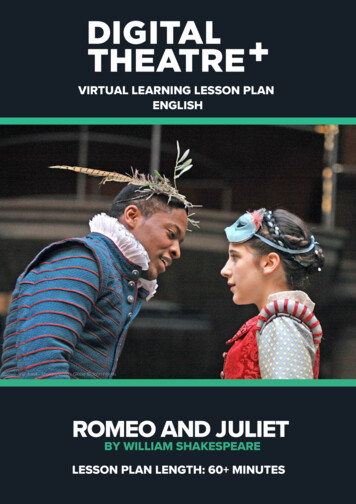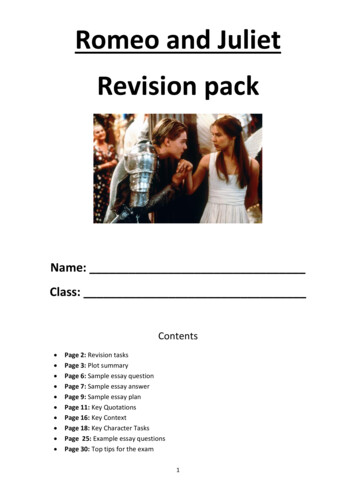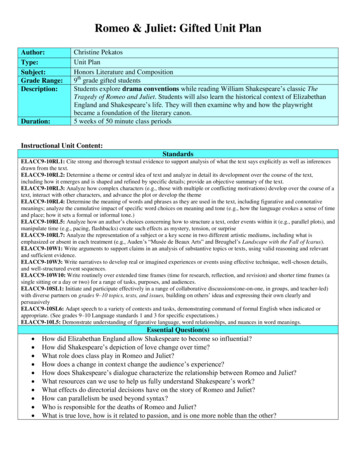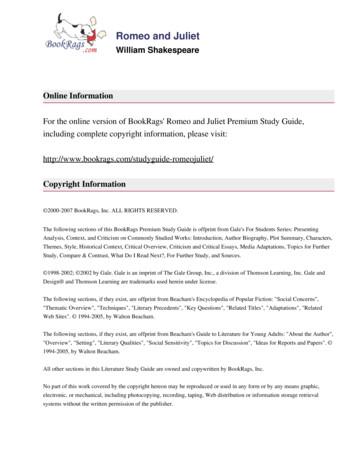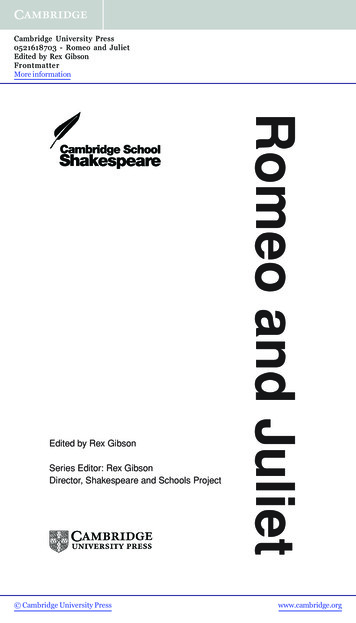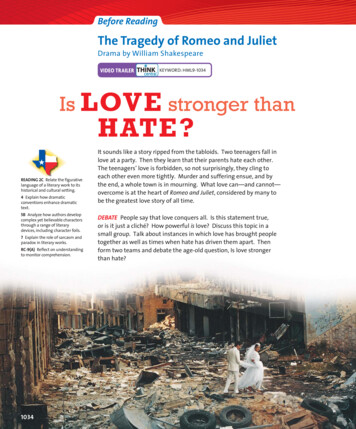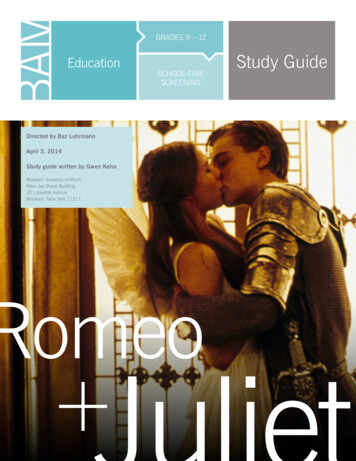
Transcription
GRADES 9—12EducationSCHOOL-TIMESCREENINGDirected by Baz LuhrmannApril 3, 2014Study guide written by Gwen KelsoBrooklyn Academy of MusicPeter Jay Sharp Building30 Lafayette AvenueBrooklyn, New York 11217Romeo Study Guide
TABLE OF :The ProductionThe CharactersEnrichment Activity:Enrichment Activity:Enrichment Activity:Enrichment Activity:CreditsSynopsis CircleDesign Elements, Be the DirectorThe PrologueAdaptation; ResourcesDEAR EDUCATORWelcome to BAM Education! We hope this study guide willenrich your classroom study of Baz Luhrmann’s 1996 film,Romeo Juliet. Both Shakespeare’s original text and Luhrmann’sadaptations will be addressed throughout this guide.As you explore Shakespeare’s text, remember that Shakespearewrote for actors; the words were always intended to be said outloud, not read quietly at a desk. If you are looking for a rewardingaccess point to language and storytelling, have your studentsread aloud or act out small scenes.YOUR VISIT TO BAMThe BAM program includes: this study guide, a pre-performanceworkshop in your classroom led by a BAM teaching artist, and thefilm screening immediately followed by a post-show discussion (30minutes). Please arrange for your students to stay and participatein this unique question-and-answer session.HOW TO USE THIS GUIDEArts experiences resonate most strongly for students when themesand ideas from the performance can be aligned to your currentcurriculum. This resource guide has been created to provide youwith background information to help you prepare your students tosee Romeo Juliet. Depending on your needs, you may chooseto use certain sections that directly pertain to your curriculum, oruse the guide in its entirety. We encourage you to print, photocopy,and share pages of this guide with your students. At the end ofthe guide you will find suggested classroom activities linked to theCommon Core Standards that you can implement before or afterattending the performance. In addition, we encourage you to print,copy, and distribute parts of this guide to your classes before theperformance.The overall goals of this guide are to:· connect to your curriculum with Common Core informationand activities;· reinforce and encourage your students to exercise their criticaland analytical thinking skills;· provide you with the necessary tools to have an engaging,educational, and inspiring experience at BAM.Look for alignment to Common Core Standards listed in boldand NYC Department of Education’s Blueprints for the Arts listedin italics.2 · ROMEO JULIET
THE PRODUCTIONTHE DIRECTORBaz Luhrmann is an Australian director most recently known fordirecting F. Scott Fizgerald’s The Great Gatsby. Other directingcredits include Moulin Rouge and Strictly Ballroom. For a full listof Luhrmann’s films, visit IMDB.In this modernized version of Shakespeare’s classic, Luhrmannsets the play in Verona Beach, CA, a gritty gang-filled worldwhere guns bear the names dagger and sword.When asked about directing Romeo Juliet, Luhrmann said:With Romeo and Juliet what I wanted to do was to look atthe way in which Shakespeare might make a movie of oneof his plays if he was a director. How would he make it?We don’t know a lot about Shakespeare, but we do knowhe would make a movie’ movie. He was a player. Weknow about the Elizabethan stage and that he was playingfor 3000 drunken punters, from the street sweeper to theQueen of England—and his competition was bear-baitingand prostitution. So he was a relentless entertainer and auser of incredible devices and theatrical tricks to ultimatelycreate something of meaning and convey a story. That waswhat we wanted to do.—Baz Luhrmann Read full article hereLuhrmann made a number of changes to Shakespeare’s originaltext when making Romeo Juliet. Most notably:· First names were given to both the Capulet andMontague parents.· The House of Capulet and the House of Montague are tworival companies.· The character of the Prince (originally the royal Prince ofVerona) was changed to Captain Prince (a police captain ofVerona Beach).· The location was changed from Verona, Italy to Verona Beach,CA. The movie itself was shot on location in Mexico.· Luhrmann switched Gregory and Sampson from the House ofCapulet to the House of Montague.· Friar Lawrence became a priest and Friar John was cut fromthe story entirely.· The prologue is done as part of a newscast.· As written by Shakespeare, Romeo dies moments before Julietawakes. In Luhrmann’s version, Juliet awakes to see Romeotake the fatal poison; the two share a few moments togetherbefore he dies (and she kills herself).· Friar Lawrence does not discover the still living Juliet clinging toher dead Romeo.· The last words of the movie are spoken as part of a newscast,not by the Prince.3 · ROMEO JULIETTHE CASTLeonardo DiCaprioClaire DanesJohn LeguizamoHarold PerrineauPete PostlethwaitePaul SorvinoBrian DennehyPaul RuddVondie Curtis-HallMiriam MargolyesChristina PicklesDiane VenoraRomeoJulietTybaltMercutioFather LaurenceFugencio CapuletTed MontagueDave ParisCaptain PrinceThe NurseCaroline MontagueGloria Capulet** bolded character names represent an addition or changeto Shakespeare’s original **
THE CHARACTERSHouse of CapuletLady Capulet & Lord Capulet: marriedJuliet: their daughter, secretly marries RomeoTybalt: Juliet’s cousin, kills Mercutio then is killed by RomeoPetruchio: friend of TybaltNurse: Juliet’s caretakerPeter**Sampson and Gregory (in Shakespeare’s Romeo and Juliet,servants to Capulet; in Luhrmann’s Romeo Juliet, servants toMontague)House of MontagueLady Montague & Lord Montague: marriedRomeo: their son, secretly marries JulietBenvolio: Romeo’s cousinBalthasar: servant to Romeo***Abram and Petruchio (in Shakespeare’s Romeo and Juliet,servants to Montague; in Luhrmann’s Romeo Juliet, servants toCapulet. “Abram” changed to “Abra”)House of EscalusEscalus: the Prince, banishes Romeo from VeronaParis: suitor to Juliet, cousin of the PrinceMercutio: kinsman to the Prince, slain by Tybalt when defendingRomeoSupporting CharactersFriar Lawrence: marries Romeo Juliet and concocts the plan tofake Juliet’s deathFriar John (cut from Luhrmann’s version): sent to Mantua to tellRomeo of the Friar’s plan. He is quarantined and never arrivesApothecary: illegally sells Romeo poison4 · ROMEO JULIET
ENRICHMENT ACTIVITYSynopsis CirclePreparation· Photocopy the quotes listed on the next page and cut them apart.· Give each student one of the quotes.· Have students take a moment to rehearse their line by sayingit out loud.· You can take this activity to the next level by having studentsadd a physical gesture to the line while saying it.· Then, read the synopsis aloud and have students insert theircorresponding line (and gesture). The more dramatic, the better!Synopsis:The play begins with a prologue that famously tells the audiencewhat they are about to see. (In Romeo Juliet, the prologueis done as a newscast. The House of Capulet and the House ofMontague are two rival companies of Verona Beach.)1. A prologue tells us what we are about to see.2. A violent fight erupts between supporters of the House ofCapulet and the House of Montague.3. The Prince intervenes and warns that another fight will result inthe death of the perpetrators.4. Romeo, a Montague, was not at the fight. It is revealed that heis lovesick for Rosaline, who does not love him back. Benvoliosuggests that the best way for Romeo to get over hislovesickness is to meet other girls. Romeo agrees to sneakinto the Capulet’s masque (party) that evening.5. Paris is eager to marry Juliet; Capulet, Juliet’s father, feelsthat his daughter is too young to marry,6. Eventually though, Capulet acquiesces. Juliet’s mother, Capuletand the Nurse break the news of Paris’ intentions to Juliet. TheNurse wishes Juliet great happiness.7. The evening of the Capulet party, Romeo, Benvolio andMercutio are discovered by Tybalt. Capulet warns Tybalt toleave them alone.13. With the help of Lawrence, Romeo and Juliet are married.14. Tybalt, still furious over Romeo’s party crashing, seeks (thenow secretly married) Romeo for a duel. Romeo tries to keepthe peace.15. A fight erupts and Mercutio is slain by Tybalt. Dying,Mercutio exclaims “a plague on both your houses.” Anenraged Romeo kills Tybalt.16. Upon learning what has transpired between Tybalt and Romeo,Prince exiles Romeo.17. Before departing Verona, Romeo spends the night with Juliet.Capulet thinks that Juliet’s grief is over the death of her cousinTybalt. He decides the best way to end her grief is to marry herto Paris. Juliet informs her parents that she will not marryParis.18. Capulet threatens to disown Juliet.19. When Juliet turns to her mother for help, her mother leavesher. Grief stricken, Juliet seeks council from Lawrence, whoprovides her with a drug that mimics death, thus stopping hermarriage to Paris.20. In the meantime, Lawrence will send word to Romeo to returnto Verona and all will be well. Unfortunately, the messengersent to Romeo does not reach him in time. Instead, Balthasartells Romeo that Juliet is dead.21. Grief-stricken, Romeo visits an apothecary, who provideshim with a deadly poison.22. Romeo returns to Verona and to the Capulet crypt. Paris,thinking that Romeo is there to vandalize the crypt, confrontshim. Paris is killed in the ensuing duel. Believing Juliet to bedead, Romeo drinks the poison and dies.8. Romeo and Juliet see each other and fall in love.23. Juliet awakes to find Romeo dead. Without a “friendly drop”of poison left, Juliet stabs herself and dies.9. In what is now famously called “the balcony scene”, Romeosneaks into the Capulet orchard and overhears Juliet professingher love for him.24. Lawrence returns and explains what has transpired to thePrince, the Montagues and Capulets. As a result of thistragedy, the two families reconcile their differences.10. Romeo makes his presence known and professes his lovefor Juliet.11. The two agree to be married the next day.12. The next morning, Juliet sends her nurse to learn what timeshe is to meet Romeo. After teasing Juliet, the Nurse revealsthat Juliet is to meet Romeo at Friar Lawrence’s later thatevening.5 · ROMEO JULIET
ENRICHMENT ACTIVITYSynopsis Circle ContinuedNOTE: In the movie, Paris is not killed, Friar Lawrence doesnot flee after discovering Juliet and the dead Romeo, andthe prologue and epilogue are spoken as a newscast.14. Gentle Mercutio, put thy rapier up. —Romeo (3.1)1. A pair of star-crossed lovers take their lives. —Chorus16. And for that offenceImmediately we do exile him hence. —(Captain) Prince (3.1)15. O, I am fortune’s fool! —Romeo (3.1)2. This quarrel is between our masters, and us their men.—Gregory (1.1)17. He shall not make me there a joyful bride! —Juliet (3.5)3. If ever you disturb our streets again,Your lives shall pay the forfeit of the peace.—(Captain) Prince (1.1)18. An you be mine, I’ll give you to my friend;An you be not, hang, beg, starve, die in the streets ”—(Fugencio) Capulet (3.5)4. Go thither, and with unattained eyeCompare her face with some that I shall show —Benvolio (1.2)19. And this shall free thee from this present shame —Friar (Priest) Lawerence20. Her body sleeps in Capel’s monument —Balthasar (5.1)5. Let two more summers wither in their prideEre we may think her ripe to be a bride. —Capulet (1.2)6. Go girl, seek happy nights to happy days. —Nurse (1.3)21. Put this in any liquid thing you willAnd drink it off, and if you have the strengthOf twenty men, it would dispatch you straight.—Apothecary (5.1)7. Content thee, gentle coz, let him alone. —Capulet (1.4)8. If I profane with my unworthiest handThis holy shrine, the gentle sin is this:My lips, two blushing pilgrims ready standTo smooth that rough touch with a tender kiss.—Romeo (1.5)9. O Romeo, Romeo! Wherefore art thou Romeo?Deny thy father and refuse thy name;Or if thou wilt not, be but sworn my love,And I’ll no longer be a Capulet. —Juliet (2.2)10. Call me but love, and I’ll be new baptized. —Romeo (2.2)11. Good night, good night! Parting is such sweet sorrowThat I shall say good night till it be morrow. —Juliet (2.2)12. There stays a husband to make you a wife. —Nurse (2.5)13. Come, come with me, and we will make short work .Til Holy Church incorporate two in one.—Friar (Priest) Lawrence6 · ROMEO JULIET22. .O true apothecary!Thy drugs are quick! Thus with a kiss I die. —Romeo (5.3)23. Yea, noise? Then I’ll be brief. O happy dagger!This is thy sheath; there rust and let me die. —Juliet (5.3)24. For never was a story of more woeThan this of Juliet and her Romeo. —(Captain) Prince (5.3)Blueprint: TheatermakingCCSS.ELA-Literacy.RL.9-10.3 Analyze how complex characters (e.g., those withmultiple or conflicting motivations) develop over the course of a text, interact withother characters, and advance the plot or develop the theme.CCSS.ELA-Literacy.RL.11-12.3 Analyze the impact of the author’s choices regardinghow to develop and relate elements of a story or drama (e.g., where a story is set,how the action is ordered, how the characters are introduced and developed).
ENRICHMENT ACTIVITYENRICHMENT ACTIVITYDesign ElementsBe The DirectorCostumes play a large role in Luhrmann’s adaptation of Romeoand Juliet.Read Act 5 scene 3 (available for free by using the FolgerDigital Text ).Share the below quote with your class. Have your studentspay close attention to what the characters wear when seeingthe movie. Afterwards, discuss:Pay close attention to how Luhrmann ends the movie. Notethe changes he made from Shakespeare’s original text (in particular, the timing of Romeo and Juliet’s deaths). As a class,discuss what effect(s) these changes had on the story.What does a character’s costume tell us about him/her?Are there differences between how the Capulets andMontagues dress in the film? If so, what are they? Whatdo you think this tells us about the two families?“Romeo and Juliet were our hardest because there is somuch baggage attached to them. Everyone has their ownvision of them. So, our first goal was to really concentrateon them, to work out how we could relieve them of all thatexpectation, so they could have their own life in this film.Ultimately, it seemed that the best thing to do was to letClaire and Leonardo become Romeo and Juliet, that theirinterpretations would create the personas of the characters.To allow them to do that, I thought that Romeo and Julietshould be different from everyone else in the piece, but theycouldn’t be so different that they’d be conspicuous or so thatthe audience would think they were special. The result wasthat we made their clothes the simplest of all, very cleanlines, not embellished at all.”– Kym Barrett, costume designerDivide into small groups for group discussion. Allow eachgroup to come up with their own ending. What effect do theywant to have on their audience?Using the text as a guide, allow students to cut out, rearrangeor edit the language to tell their version of the story. Be sure tohave each group explain their choices.Blueprint: Literacy in the Arts and Making ConnectionsCCSS.ELA-Literacy.CCRA.SL.1 Prepare for and participate effectively in a rangeof conversations and collaborations with diverse partners, building on others’ideas and expressing their own clearly and persuasively.Learn more on the artistic vision with the film’s productionnotesPhoto: Martin SkoogBlueprint: Literacy in the Arts and Making Connections7 · ROMEO JULIET
ENRICHMENT ACTIVITYENRICHMENT ACTIVITYWhat Do We Learn from the Prologue?HEARTBEAT (ba DUM ba DUM ba DUM)The prologue provides the audience with information aboutthe world of the play before it even begins. It’s a great place tostart a conversation about Romeo and Juliet.Shakespeare wrote the prologue in perfect iambic pentameter(ten-syllable sentences that follows an unstressed/stressedrhythm). Iambic pentameter is the rhythm of the human heart.As a group, read the prologue aloud.Have students add a gesture to each line.· Take a moment for students to “beat out” the rhythm ofthe prologue by placing their hand over their heart.· Discuss what clues this rhythm tells us about operative(important) words (hint: usually in the stressed position).· Why would Shakespeare open a play with a heartbeat?Discuss:· What information is given about the play?· What do we know about the world of Verona fromthe prologue?· What is the meaning of “star-crossed?”· What role does fate play in Romeo and Juliet?\Once you have read the play (or seen the movie), havestudents break into small groups. Assign each group acharacter (not Romeo or Juliet).Within the small group, read the prologue aloud again.Have students pay attention to what information is includedand what information is left out.Have each group rewrite the prologue from their assignedcharacter’s point of view and share with the class.CCSS.ELA-Literacy.CCRA.R.4 Interpret words and phrases as they are used ina text, including determining technical, connotative, and figurative meanings,and analyze how specific word choices shape meaning or tone.8 · ROMEO JULIETTwo households, both alike in dignity,In fair Verona, where we lay our scene,From ancient grudge break to new mutiny,Where civil blood makes civil hands unclean.From forth the fatal loins of these two foesA pair of star-crossed lovers take their life,Whose misadventured piteous overthrowsDo with their death bury their parents’ strife.The fearful passage of their death-marked love,And the continuance of their parents’ rage,Which, but their children’s end, nought could remove,Is now the two hours’ traffic of our stage;The which if you with patient ears attend,What here shall miss, our toil shall strive to mend.
ENRICHMENT ACTIVITYMaking Choices: The DirectorShakespeare’s plays are often adapted for film. The richlanguage, passionate characters and complex relationshipslend themselves to the big screen, and to different directorialinterpretations.Take a moment to watch different clips from various versionsof Romeo and Juliet. Notice the differences (and similarities?)in each version.Pay particular attention to the costumes, music, location eachdirector chooses.What effect does each of these elements have on the story?Which of these adaptations speak to you? Why?Prologue Act 1 Scene 1Franco ZeffirelliWest Side Story film adaptation by Leonard WhitingAct 2 Scene 2 – “The Balcony Scene”Franco ZeffirelliRoyal Shakespeare CompanyWest Side StoryENRICHMENT ACTIVITYOther AdaptationsThere are many film versions and adaptations ofShakespeare’s Romeo and Juliet. Most notably:The 1968 Franco Zeffirelli film starring Leonard Whiting andOlivia Hussey.The 1961 film, West Side Story directed by Robert Wise andJerome Robbins, starring Natalie Wood and Richard Beymer.On stage most recently, Orlando Bloom and Condola Rashadstarred in the title roles as Romeo and Juliet on Broadway. Afilm version of this production will be released this spring.9 · ROMEO JULIETRESOURCESThere are many resources available to help enrich your study ofRomeo and Juliet. For a free, downloadable version of the text, besure to check out the Folger Theatre’s digital texts.The Royal Shakespeare Company (RSC) has a number of clipsand resources that can enrich your classroom experience. Click on“Romeo and Juliet” in the RSC’s resource bank for activities andresources:· Hear an interview with Leonardo DiCaprio on Shakespeare· Hear Baz Luhrmann discuss the importance of “the pitch” ingetting the movie produced. (A “pitch” is where a filmmakeror director tries to convince a producer to make his or her film)
Title sponsor of BAM Rose Cinemas & BAMcinematek:Major support for BAM Education programs provided by:BAM Education & HumanitiesThe mission of BAM Education & Humanities is to ignite imagination and ideasthrough programs that enrich the audience experience, spark conversation, andgenerate creative engagement.BAM Education connects learning with creativity, engaging imagination byencouraging self-expression through in- and after-school arts educationprogramming, workshops for students and teachers, school-time performances,and summer arts programs.Leadership support for BAM’s Shakespeare Education programs provided byBetsy and Ed Cohen, and The Corinthian Foundation.Leadership support for BAM Education Programs is provided by the AltmanFoundation; The Irene Diamond Fund; The Rita and Alex Hillman Foundation;Martha A & Robert S. Rubin; The Della Rosa Family Foundation; and Judithand Alan Fishman.Expansion of BAM’s Community and Education Programs made possible bythe support of The SHS Foundation.Leadership support for school-time performances, pre-show preparationworkshops, and educational film screenings is provided by The Simon andEve Colin Foundation, Inc. and Lemberg Foundation.Leadership support for educational film screenings and Brooklyn Reads isprovided by Goldman Sachs Gives at the recommendation of David and SusanMarcinek.Development of new education and community initiatives at the BAM Fisher supported by Brooklyn Community Foundation; Rockefeller Brothers Fund; and TheSkirball Foundation.Education programs at BAM are supported by:Altman Foundation; Jody and John Arnhold; Barker Welfare Foundation; TigerBaron Foundation; The Bay and Paul Foundations; The Bloomingdale’s Fund ofthe Macy’s Foundation; The Simon and Eve Colin Foundation; Constans CulverFoundation; Robert and Mercedes Eichholz Foundation; William and Mary GreveFoundation; The Hasty Pudding Institute of 1770; Charles Hayden Foundation;Jaharis Family Foundation; Emily Davie and Joseph S. Kornfeld Foundation;Lemberg Foundation; National Grid; The Jerome Robbins Foundation, Inc.; TheDavid Rockefeller Fund; May and Samuel Rudin Family Foundation; In Memory ofRobert Sklar; Sills Family Foundation; Joseph and Silvia Slifka Foundation; TheAlvin and Fanny B. Thalheimer Foundation; Travelers Foundation; Michael TuchFoundation; Turrell Fund; and the Joseph LeRoy and the Ann C. Warner Fund.Education programs at BAM are endowed by:Lila Wallace-Reader’s Digest Endowment Fund for Community, Educational, &Public Affairs Programs; Martha A. and Robert S. Rubin; William Randolph HearstEndowment for Education and Humanities Programs; The Irene Diamond Fund;and The Robert and Joan Catell Fund for Education Programs.Your tax dollars make BAM programs possible through funding from:BAM would like to thank the Brooklyn Delegations of the New York StateAssembly, Joseph R. Lentol, Delegation Leader; and New York Senate,Senator Velmanette Montgomery, Delegation Leader.The BAM facilities are owned by the City of New York and benefit from publicfunds provided through the New York City Department of Cultural Affairs withsupport from Mayor Bill De Blasio; the New York City Council including CouncilSpeaker Melissa Mark-Viverito, Finance Committee Chair Julissa Ferreras ,Cultural Affairs Committee Chair Jimmy Van Bramer, the Brooklyn Delegationof the Council, and Councilwoman Laurie Cumbo; and Brooklyn BoroughPresident Eric Adams.After-School Programs & In-School Residencies:Young Film CriticsArts & JusticeDancing Into the FutureShakespeare Teaches StudentsShakespeare Teaches TeachersYoung ShakespeareAfricanDanceBeatDepartment of Education and Humanities Staff:Stephanie Hughley: VP Education & HumanitiesSteven McIntosh: Director of Education and Family ProgramsJohn P. Tighe, DMA: Assistant DirectorViolaine Huisman: Humanities DirectorShana Parker: Director of Operations for Education & HumanitiesJohn S. Foster, Ph.D.: Education ManagerVerushka Wray: Program ManagerEveline Chang: Program ManagerJennifer Leeson: Operations Manager for Education & HumanitiesNathan Gelgud: Box Office ManagerCathleen Plazas: Internship CoordinatorMolly Silberberg: Humanities CoordinatorTamar MacKay: Education AssistantRebekah Gordon: Administrative AssistantVictoria Collado: Education InternDaniel Balkin: Humanities InternAbout the WriterGwendolyn Kelso is currently a lead teaching artist for Brooklyn Academy ofMusic. As a teaching artist and professional actor, she has worked for theRepertory Theatre of Saint Louis, Appletree Theatre (Chicago), ZACH Theatre(Austin) and Austin Shakespeare Festival. Here in New York, Gwendolyn is theco-founder of Hedgepig Ensemble Theatre, a company dedicated to helpingwomen find a voice in classic theater. She has an MFA in classical acting fromthe Shakespeare Theatre, DC. gwendolynkelso.comCopyright 2014 by Brooklyn Academy of MusicAll rights reserved. No part of this book may be reproduced or transmitted inany form or by any means, electronic or mechanical, including photography,recording, or by any information storage and retrieval system, withoutpermission in writing from the Brooklyn Academy of Music.
Romeo: their son, secretly marries Juliet Benvolio: Romeo's cousin Balthasar: servant to Romeo ***Abram and Petruchio (in Shakespeare's Romeo and Juliet, servants to Montague; in Luhrmann's Romeo Juliet, servants to Capulet. "Abram" changed to "Abra") House of Escalus Escalus: the Prince, banishes Romeo from Verona
